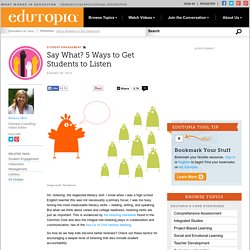

Teaching Your Students How to Have a Conversation. I was recently in a third grade classroom and was struck by the presence of rules that were posted for how to have a conversation.

The poster said, "Each person must contribute to the discussion but take turns talking. Ask each other, 'Would you like to add to my idea? ' or 'Can you tell us what you are thinking? ' Ask questions so that you understand each other's ideas. Say, 'Can you tell me more about that? ' Having visited many middle and high schools, I think these same rules could -- and probably should -- be posted there as well. Maybe you have also observed how common it is nowadays for students to not know how to have a conversation. 8 Tips for Speaking and Listening While it is impossible to know all of the reasons, there is no doubt that learning to listen and talk is an extremely important way to broaden knowledge, enhance understanding and build community. 1.
ClipArt ETC: Free Educational Illustrations for Classroom Use. Alphabets The Alphabets ClipArt collection offers 1,193 illustrations arranged in 43 galleries including decorative letters and numerals, complete alphabet sets, and several sign language systems.

If you are looking… American History and Government The American History and Government ClipArt collection offers 2,513 illustrations arranged in 26 galleries. The images range from exploration and Colonial America, to the American Revolution and Civil… Dyslexi. EdResearch. Franska. Free Posters - Poster-Street.com. Ba Ba Dum.
Vad gör en skicklig lärare? Avhandling. Online Teaching Ideas. Teacher tools. Förstelärare. Förstelärare. Lärarens roll. How A Good Teacher Becomes Great. Good teachers are amazing–and rare.

The ignorance of the Those who can’t, teach mantra is frightening–being a good teacher is an incredible challenge to achieve consistently. Good teachers use data to drive instruction, know the ins and outs of their curriculum, have refined assessments over and over until they measure depth of content knowledge and not procedural knowledge or some crazy game of remember what the teacher said, or guess what the teacher’s thinking. They support students in self-directed learning, know how technology actually improves learning, and exude a charisma that makes students eager to learn from them. They know which assessments are for “show,” and which are for “go”—that is, which look good from 10 feet, and which provide visibility for both the student and teacher where the learning needs to go next. Good teachers create positive environments for students where each learner feels safe to share thinking, ask questions, and participate in conversations naturally. 10. What an Effective Teacher's Classroom Looks Like.
Another school year is approaching and many novice teachers are preparing to enter their own classrooms for the first time.

To help them on their way, MiddleWeb is publishing a series of brief articles offering good advice and food for thought. What We See in Effective and Ineffective Classrooms by Annette Breaux and Todd Whitaker In our ongoing observations of teachers, we continue to notice that the most effective teachers’ classrooms all look uncannily similar. And, of course, the same can be said for the less effective teachers—their classrooms all look uncannily similar.
It seems that no matter where we go, the students all act the same in the classrooms of the most effective teachers. Let’s take a look inside of less effective teachers’ classrooms first. Here is what they all seem to have in common: ◆ The classroom looks disorganized. Now for the good news We could go on, but we think we’ve made the point. Here’s what we saw in the classrooms of the most effective teachers: Say What? 5 Ways to Get Students to Listen. Ah, listening, the neglected literacy skill.

I know when I was a high school English teacher this was not necessarily a primary focus; I was too busy honing the more measurable literacy skills -- reading, writing, and speaking. But when we think about career and college readiness, listening skills are just as important. This is evidenced by the listening standards found in the Common Core and also the integral role listening plays in collaboration and communication, two of the four Cs of 21st century learning. So how do we help kids become better listeners? Check out these tactics for encouraging a deeper level of listening that also include student accountability: Strategy #1: Say it Once Repeating ourselves in the classroom will produce lazy listening in our students. Of course you don't want to leave distracted students in the dust so for those few who forgot to listen, you can advise them to, "ask three, then ask me.
" Strategy #2: Turn and Talk Strategy #3: Student Hand Signals.